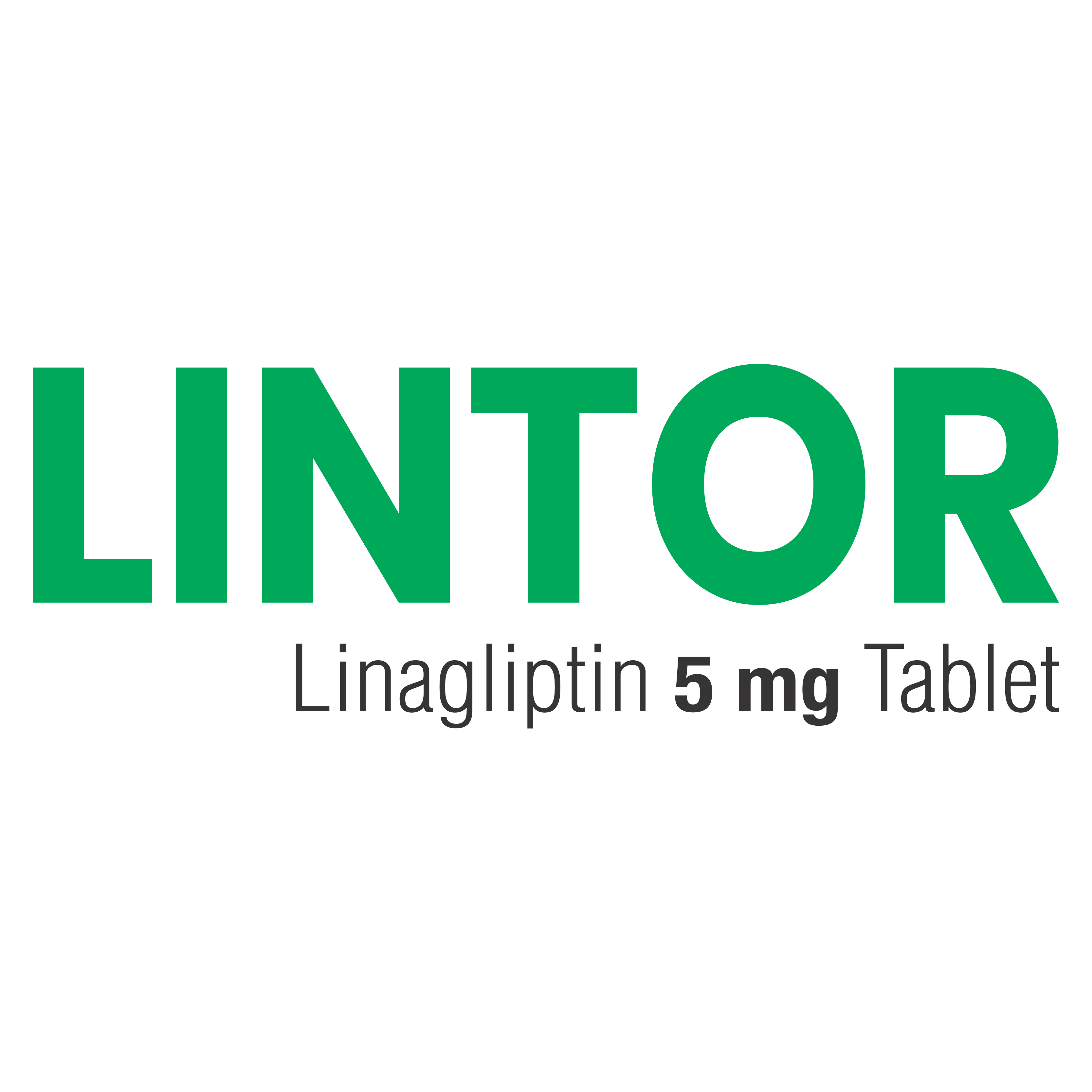LINTOR
| Generic Name | Linagliptin |
| Strength | 5 mg |
| Dosage Form | Tablet |
Description
LINTOR is an oral diabetes medicine that helps control blood sugar levels. It works by regulating the levels of insulin your body produces after eating. It is used together with diet and exercise to improve blood sugar control in adults with type 2 diabetes mellitus. This medicine is not for treating type 1 diabetes.

Product Information Leaflet
Read all of this leaflet carefully before you start taking this medicine because it contains important information for you.
Keep this leaflet. You may need to read it again.
If you have any further questions, ask your doctor, pharmacist or nurse.
This medicine has been prescribed for you only. Do not pass it on to others. It may harm them, even if their signs of illness are the same as yours.
If you get any side effects talk to your doctor, pharmacist or nurse. This includes any possible side effects not listed in this leaflet. See section 4.
What is in this leaflet:
1. What Lintor is and what it is used for
2. What you need to know before you take Lintor
3. How to take Lintor
4. Possible side effects
5. How to store Lintor
6. Contents of the pack and other information
1. What Lintor is and what it is used for
Lintor contains the active substance Linagliptin which belongs to a group of medicines called “oral anti-diabetics”. Oral anti-diabetics are used to treat high blood sugar levels. They work by helping the body reduce the level of sugar in your blood.
Lintor is used for ‘type 2 diabetes’ in adults, if the disease cannot be adequately controlled with one oral anti-diabetic medicine (metformin or sulphonylureas) or diet and exercise alone. Lintor may be used together with other anti-diabetic medicines (insulin, metformin or sulphonylureas e.g. glimepiride, glipizide).
It is important to keep following the advice about diet and exercise that you have been given by your doctor or nurse.
2. What you need to know before you take Lintor
Do not take Lintor
If you are allergic to Linagliptin.
Warnings and precautions
Talk to your doctor, pharmacist or nurse before taking Lintor if you:
- have type 1 diabetes (your body does not produce any insulin) or diabetic ketoacidosis (a complication of diabetes with high blood sugar, rapid weight loss, nausea or vomiting). Lintor should not be used to treat these conditions.
- are taking an anti-diabetic medicine known as a ‘sulphonylurea’ (e.g. glimepiride, glipizide), your doctor may want to reduce your dose of sulphonylurea when you take it together with Lintor in order to avoid your blood sugar going too low.
- have had allergic reactions to any other medicines that you take to control the amount of sugar in your blood. have or have had a disease of the pancreas.
If you have symptoms of acute pancreatitis, like persistent, severe stomach ache (abdominal pain), you should consult your doctor.
Diabetic skin lesions are a common complication of diabetes. You are advised to follow the recommendations for skin and foot care that you are given by your doctor or nurse.
Children and adolescents
Lintor is not recommended for children and adolescents under 18 years.
Elderly
Experience in patients older than 80 years is limited. These patients should therefore be treated carefully.
Other medicines and Lintor
Tell your doctor or pharmacist if you are taking, have recently taken or might take any other medicines.
In particular, you should tell your doctor if you are using medicines containing any of the following active substances:
- Carbamazepine, phenobarbital or phenytoin. These may be used to control fits (seizures) or chronic pain.
- Rifampicin. This is an antibiotic used to treat infections such as tuberculosis.
Pregnancy and breast-feeding
If you are pregnant or breast-feeding, think you may be pregnant or are planning to have a baby, ask your doctor or pharmacist for advice before taking this medicine.
It is unknown if Lintor is harmful to the unborn child. Therefore, it is preferable to avoid using Lintor if you are pregnant.
It is not known if Lintor passes into human breast milk. A decision must be made by your doctor whether to discontinue breast-feeding or to discontinue/abstain from Lintor therapy.
Driving and using machines
Lintor has no or negligible influence on the ability to drive and use machines.
Taking Lintor in combination with medicines called sulphonylureas and/or insulin can cause too low blood sugar levels (hypoglycaemia), which may affect your ability to drive and use machines or work without safe foothold. However, more frequent blood glucose testing might be recommended to minimise the risk for hypoglycaemia, especially when Lintor is combined with sulphonylurea and/or insulin.
3. How to take Lintor
Always take this medicine exactly as your doctor has told you. Check with your doctor or pharmacist if you are not sure.
The recommended dose of Lintor is one 5 mg tablet twice a day.
You can take Lintor with or without food.
Your doctor may prescribe Lintor together with another oral anti-diabetic medicine. Remember to take all medicines as directed by your doctor to achieve the best results for your health.
If you take more Lintor than you should
If you take more Lintor than you should, talk to a doctor immediately.
If you forget to take Lintor
If you forget to take a dose of Lintor, take it as soon as you remember it. However, if it is nearly time for the next dose, skip the missed dose.
Do not take a double dose to make up for a forgotten dose. Never take two doses on the same day.
If you stop taking Lintor
Do not stop taking Lintor without first consulting your doctor. Your blood sugar levels may increase when you stop taking Lintor.
If you have any further questions on the use of this medicine, ask your doctor, pharmacist or nurse.
4. Possible side effects
Like all medicines, this medicine can cause side effects, although not everybody gets them.
Some symptoms need immediate medical attention
You should stop taking Lintor and see your doctor immediately if you experience the following symptoms of low blood sugar: trembling, sweating, anxiety, blurred vision, tingling lips, paleness, mood change or confusion (hypoglycaemia). Hypoglycaemia (frequency: very common, may affect more than 1 in 10 people) is an identified side effect when Lintor is taken together with metformin and a sulphonylurea.
Some patients have experienced allergic reactions (hypersensitivity; frequency uncommon, may affect up to 1 in 100 people while taking Lintor alone), which may be serious, including wheezing and shortness of breath (bronchial hyperreactivity; frequency not known while taking Lintor alone, frequency cannot be estimated from the available data). Some patients experienced rash (frequency uncommon), hives (urticaria; frequency rare, may affect up to 1 in 1000 people), and swelling of the face, lips, tongue, and throat that may cause difficulty in breathing or swallowing (angioedema; frequency rare). If you experience any of the signs of illness mentioned above, stop taking Lintor and call your doctor right away. Your doctor may prescribe a medicine to treat your allergic reaction and a different medicine for your diabetes.
Some patients have experienced inflammation of the pancreas (pancreatitis; frequency not known while taking Lintor alone). STOP taking Lintor and contact a doctor immediately if you notice any of the following serious side effects:
- Severe and persistent pain in the abdomen (stomach area) which might reach through to your back, as well as nausea and vomiting, as it could be a sign of an inflamed pancreas (pancreatitis).
Some patients have had the following side effects while taking Lintor alone:
- Uncommon: inflamed nose or throat (nasopharyngitis), cough, allergic reactions (hypersensitivity).
- Rare: level of amylase in the blood increased.
Some patients have had the following side effects while taking Lintor and metformin: - Uncommon: inflamed nose or throat (nasopharyngitis), allergic reactions (hypersensitivity), cough, level of amylase in the blood increased.
Some patients have had the following side effects while taking Lintor and insulin:
- Uncommon: inflamed nose or throat (nasopharyngitis), allergic reactions (hypersensitivity), cough, pancreatitis, constipation.
- Not known: level of amylase in the blood increased.
Some patients have had the following side effects while taking Lintor, metformin and a sulphonylurea:
- Uncommon: allergic reactions (hypersensitivity), level of amylase in the blood increased.
- Not known: inflamed nose or throat (nasopharyngitis), cough.
Other side effects of Lintor include:
- Not known: blistering of skin (bullous pemphigoid).
Reporting of side effects
If you get any side effects talk to your doctor, pharmacist or nurse. This includes any possible side effects not listed in this leaflet. By reporting side effects you can help provide more information on the safety of this medicine.
5. How to store Lintor
Keep this medicine out of the sight and reach of children.
Do not use this medicine after the expiry date which is stated on the blister and the carton after EXP. The expiry date refers to the last day of that month.
Store in a dry place at or below 300C.
Do not use Lintor if the package is damaged or shows signs of tampering.
Do not throw away any medicines via wastewater or household waste. Ask your pharmacist how to throw away medicines you no longer use. These measures will help protect the environment.
6. Contents of the pack and other information
What Lintor 5 contains
The active substance is Linagliptin.
Each film-coated tablet contains Linagliptin 5 mg
Colours: Iron Oxide Red & Titanium Dioxide
What Lintor looks like and contents of the pack
Lintor 5 tablets are 6.5 mm diameter round, light red film-coated tablets debossed with “Q” logo on one side. It is available in Alu-Alu blister pack of 10 tablets. The commercial pack is of 4 x 3 x 10 Tablets.




